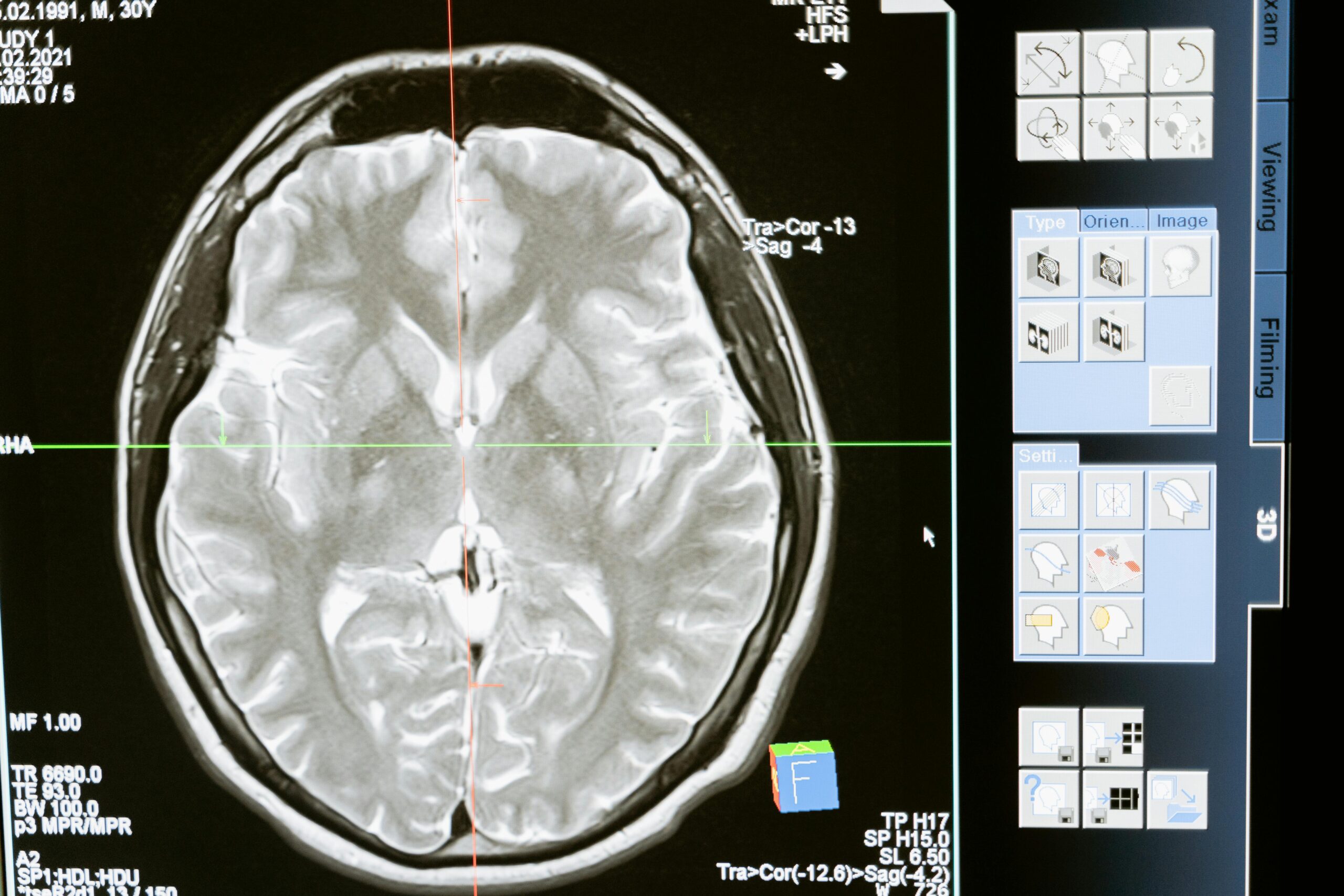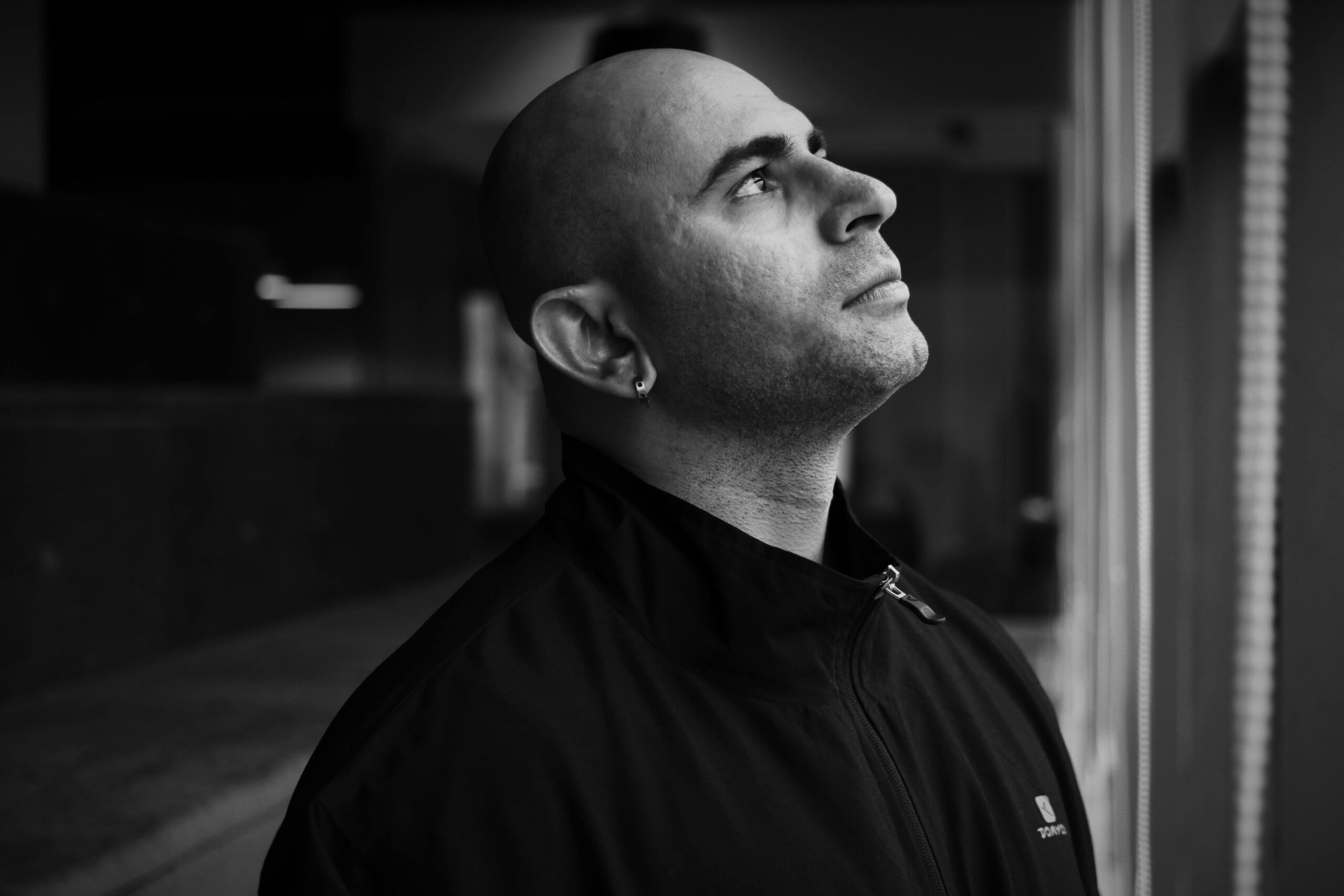
Cerebrospinal Fluid: If you’ve ever stared at a sentence three times before it made sense, walked into a room and forgot why you were there, or felt like your thoughts were wading through molasses, you’ve met brain fog. It isn’t laziness, a lack of willpower, or “just getting older.”
Brain fog is a signal—your brain’s way of saying its internal environment needs help. One of the most under-discussed drivers behind brain fog is faulty cerebrospinal fluid (CSF) dynamics, especially where the head meets the neck. When the upper cervical spine (the atlas and axis at C1–C2) is out of alignment, it can create a choke point that disrupts fluid flow, alters pressure, and irritates the delicate neural systems that power your clarity, focus, and energy.
At Lavender Family Chiropractic in Sarasota, we focus exclusively on the upper cervical spine. We use 3D CBCT imaging and functional nervous system scans (Tytron) to locate subtle misalignments that many routine exams miss—and we correct them with gentle, precise adjustments (no twisting, popping, or cracking). For many people, restoring alignment at the cranio-cervical junction helps normalize CSF drainage and venous outflow, reduces pressure, and clears the mental haze that’s been hanging around for months—or years.
Below, we’ll unpack what brain fog really is, why CSF matters so much, how upper cervical misalignment becomes a “traffic jam” for fluid flow, and what a targeted, evidence-informed care plan looks like when your goal is a clear, steady mind.
Cerebrospinal Fluid: What Is Brain Fog? Signs, Symptoms, and How It Feels Day to Day
“Brain fog” isn’t a single diagnosis—it’s a cluster of cognitive and sensory complaints that tend to travel together. Most people describe it as a persistent sense of “not feeling like myself.” Common features include:
- Difficulty concentrating or staying on task
- Short-term memory lapses (names, appointments, mid-sentence blanks)
- Slowed processing speed—everything feels one beat behind
- Word-finding problems or tip-of-the-tongue moments
- Mental fatigue that builds quickly with reading, screens, or meetings
- Disorientation or feeling “spacey,” especially in busy environments
- Low motivation or drive despite a desire to get things done
- Head pressure, head “heaviness,” or a tight band around the skull
- Sensitivity to light, motion, and complex visual patterns
- Poor stress tolerance and irritability
- Non-restorative sleep and daytime drowsiness
Brain fog often coexists with migraines, vestibular symptoms (dizziness, vertigo), neck pain, TMJ tension, and autonomic complaints (like heart-pounding or temperature swings). That overlap isn’t random—these systems meet at the upper cervical region and brainstem, which helps explain why a mechanical problem at C1–C2 can echo as cognitive haze.
Why Brain Fog Happens: A Systems View (It’s Not Just Stress)
Yes, stress plays a role. But long-standing brain fog usually involves several layers:
- Sleep quality and circadian timing: Fragmented sleep, airway issues, or poor sleep timing disrupt memory consolidation and glymphatic (night-time fluid clearance) function.
- Metabolic and hormonal factors: Thyroid sluggishness, blood sugar swings, low iron or B12, and adrenal rhythm issues sap mental energy.
- Inflammation and immune load: Post-viral states, chronic sinus congestion, gut dysbiosis, or persistent low-grade inflammation can weigh down cognition.
- Medication effects: Sedating antihistamines, certain antidepressants, and multiple-med combos can dull alertness.
- Head and neck mechanics: Whiplash, sports impacts, repetitive forward-head posture, desk strain, or dental/TMJ tension can disturb the upper neck’s alignment and, with it, CSF and venous drainage.
That last bullet—the mechanical interface at the cranio-cervical junction—is often the blind spot in standard workups. It’s where your structural health and your brain’s fluid dynamics collide.
Meet Your Cerebrospinal Fluid (CSF): The Brain’s Wash, Rinse, Repeat Cycle
Think of CSF as your brain’s internal tide. It:
- Cushions the brain and spinal cord, distributing mechanical forces
- Delivers nutrients and removes metabolic waste (including by-products of neural activity)
- Balances intracranial pressure so the brain can operate in a stable environment
CSF is produced inside the brain’s ventricles, circulates around the brain and down the spine, and drains through venous pathways for reabsorption. During deep, quality sleep, your brain’s glymphatic system opens wider “drains,” allowing CSF to rinse away cellular debris more efficiently. When the tide flows smoothly, you wake clear. When it doesn’t—because production, movement, or drainage is impaired—pressure, congestion, and toxin buildup can cloud thinking.
When CSF Flow Slows: Pressure, Congestion, and Cognitive Cloudiness
Impaired CSF dynamics typically show up in three ways:
- Increased intracranial pressure variability: Even small fluctuations can translate into head pressure, sound/light sensitivity, and fatigue.
- Stagnation and waste accumulation: Sluggish clearance means more “neural exhaust” hangs around, blunting sharpness.
- Venous outflow bottlenecks: If veins in the neck (internal jugulars, vertebral venous plexus) struggle to drain, the whole cranial system can back up—especially with certain postures or after long days at a desk.
People often report that their fog waxes and wanes with posture (worse slumping over a laptop), barometric pressure (storm days), hydration, and sleep quality. These clues point toward a fluid and pressure management problem rather than a purely psychological one.
The Upper Cervical “Choke Point”: Atlas (C1), Axis (C2), and the Cranio-Cervical Junction
Your head sits on the atlas (C1), a ring-shaped vertebra designed for precision movement. Just below is the axis (C2), whose peg-like dens acts as a pivot. This joint complex is extraordinary—but also vulnerable. Here’s why misalignment matters:
- Proximity to the brainstem: The neural hub for balance, autonomic tone, and arousal runs through this gateway.
- Crowded real estate: CSF pathways, venous sinuses, vertebral arteries, cranial nerves, ligaments, and dura all converge in a tight space.
- Dural tension: The dura mater anchors at the foramen magnum and upper cervical spine; malposition can transmit tension that subtly changes CSF pulsations and venous return.
- Postural leverage: A few millimeters of shift at C1 can reorient the head, straining suboccipital muscles, compressing soft tissues, and altering space available for fluid movement.
In practical terms: a misaligned atlas can act like a kink in a hose. The “kink” isn’t enough to stop CSF entirely—but enough to change pressure gradients, distort drainage, and accumulate the kind of irritations that feel like brain fog, head pressure, and fatigue.
How Misalignment Forms—and How It Triggers Brain Fog
Misalignment can build gradually or appear after a single event:
- Whiplash or collisions (even “minor” fender-benders)
- Sports impacts and falls (childhood to adulthood)
- Prolonged device posture (forward head, rounded shoulders)
- Bruxism and TMJ tension (jaw-neck linkage is strong)
- Airway issues and mouth breathing (head-forward posture compensation)
- Occupational strain (dentists, stylists, mechanics, desk pros)
Once alignment shifts, your body compensates: muscles guard, fascia tightens, the head tilts subtly, venous return labors, and CSF dynamics adapt in less-than-ideal ways. Over time, that can mean cognitive haze, neck stiffness, occipital neuralgia, vestibular sensitivity, and headaches—a familiar cluster we see daily.
How Upper Cervical Care Helps CSF and Clarity
Upper cervical chiropractic is a specialty focused on the atlas and axis. At Lavender Family Chiropractic, our process is meticulous:
- History & Functional Screening
We map your symptom timeline, triggers, sleep pattern, prior injuries, and vestibular/visual sensitivities. Subtle details—like feeling worse in big box stores or with scrolling—guide our focus. - 3D CBCT Imaging
Our CBCT (cone-beam CT) provides a high-resolution, three-dimensional view of your unique anatomy at the cranio-cervical junction. We measure atlas tilt/rotation, joint spacing, and structural asymmetries that standard films can miss. - Tytron Functional Nervous System Scans
This non-invasive infrared thermography assesses paraspinal temperature patterns that correlate with autonomic nerve irritation—often seen with upper neck misalignment. - Gentle, Precise Correction
We use targeted, low-force techniques to nudge the atlas and axis back into optimal alignment. There’s no popping or twisting. The correction is directional and calculated from your images. - Post-Adjustment Rechecks
We re-scan, re-assess posture, and monitor symptom changes. As the body adapts, we expect improved head carriage, easier breathing, softer suboccipital tension—and, for many, a lighter, clearer head. - Stability Plan
Early visits focus on holding the correction. We layer in simple habits—ergonomics, nasal breathing, hydration, gentle mobility—so your alignment becomes your new normal.
When the mechanical choke point is resolved, venous outflow and CSF pulsation often normalize. Patients commonly report that the “pressure valve opened,” visual motion is less irritating, they read longer without fogging, and mornings start brighter.
What to Expect at Lavender Family Chiropractic (Step by Step)
- Visit 1: Discovery & Imaging
Expect a thorough conversation about your fog patterns, headaches, dizziness, sleep, stress, and past injuries. We perform a targeted exam and, if indicated, proceed with 3D CBCT imaging and Tytron scanning. - Visit 2: Review & First Correction
We review your images in detail, explain your unique alignment (with visuals), and outline a focused plan. If you’re a candidate, you’ll receive your first gentle upper cervical correction and a post-check scan. - Early Care Phase (Weeks 1–4)
The aim is stability—fewer corrections, more holding. You’ll learn how to sit, sleep, and move to protect your alignment while your ligaments and muscles adapt. - Reevaluation
We repeat scans, compare before/after metrics, and celebrate the wins (better focus, less head pressure, steadier balance). We then taper to a maintenance rhythm tailored to your lifestyle.
We care for people across Sarasota, Bradenton, Lakewood Ranch, Parrish, Ellenton, Venice, Osprey, Punta Gorda, St. Petersburg, Siesta Key, Longboat Key, Lido Key, and Myakka City. If you’ve been searching “chiropractor Sarasota Florida,” “upper cervical chiropractor near me,” “vertigo doctor near me,” or “migraine doctor near me,” you’re in the right place.
Who Benefits? Real-World Scenarios We See Often
- The desk pro with storm-triggered fog: Head pressure rises before Gulf storms; reading spreadsheets feels impossible by 3 p.m. Post-alignment, pressure sensitivity drops and afternoons open up.
- The parent after a “small” fender-bender: Weeks later, neck is tight, memory slips, and grocery store aisles feel dizzying. Correcting C1 reduces motion sensitivity and restores confidence.
- The athlete with old concussions: Workouts are fine, but screens and meetings demolish mental stamina. Aligning the cranio-cervical junction eases fog after cognitive loads.
- The migraineur with visual snow: Not every visual phenomenon disappears, but many report fewer “thick-head” days and improved tolerance for light and motion.
Everyone’s story is unique; the common thread is a mechanical piece at the top of the spine that—when addressed—lets the brain’s fluid systems breathe.
Self-Checks: Are You Experiencing CSF-Related Brain Fog?
- Do you feel clearer after a night of truly deep sleep, yet haze returns with desk days?
- Does gentle walking outside brighten your head more than coffee does?
- Are your symptoms worse with slumped posture and better when you stack your ears over your shoulders?
- Do storms, pressure shifts, or airplane travel crank up head pressure or dizziness?
- Does looking down at a phone or scrolling fast content provoke fog or nausea?
These aren’t diagnostic, but they hint at a fluid/pressure component. If several ring true, an upper cervical evaluation is worth your time.
Complementary Habits That Support CSF Flow and Brain Clarity
Upper cervical care is the foundation; smart habits help you hold your gains.
- Hydration & electrolytes: CSF is mostly water. Aim for steady fluids through the day and consider electrolytes in Florida heat.
- Nasal breathing: Nose breathing supports nitric oxide production and better blood gases—friendlier for cerebral circulation.
- Sleep quality: Protect deep sleep with a regular schedule, cool/dark room, and evening light limits. Side-sleeping with a properly sized pillow preserves neck alignment.
- Move gently, often: Hourly posture breaks, brisk walks, and light mobility keep venous return and CSF pulsations lively.
- Ergonomics: Raise screens to eye level, bring the work to you, and sit back—don’t crane forward.
- Nutrition basics: Prioritize protein, colorful produce, omega-3s, and consider B12/iron testing if fatigue is stubborn.
- Stress rhythm: Short breathing breaks (4 seconds in, 6 out) nudge the autonomic system toward calm, which helps vascular tone.
These don’t replace care; they amplify it.
Top 15 FAQs About Brain Fog, CSF, and Upper Cervical Chiropractic
1) What exactly is brain fog?
A constellation of cognitive symptoms—poor focus, short-term memory glitches, slowed thinking, and mental fatigue—that signals your brain’s internal environment needs support.
2) How can CSF issues cause brain fog?
CSF clears waste and stabilizes pressure. If flow is restricted—often at the cranio-cervical junction—waste can linger and pressure can fluctuate, dulling clarity.
3) How does an atlas (C1) misalignment affect CSF?
A rotated/tilted atlas can crowd the foramen magnum region, alter dural tension, and hinder venous outflow—together shifting CSF dynamics.
4) What symptoms suggest a fluid/pressure component?
Head pressure, fog that worsens with screens or storms, motion/light sensitivity, neck tightness, and relief with good sleep or walking.
5) Can upper cervical care help migraines and dizziness too?
Many patients report fewer migraine days and steadier balance after alignment improves CSF/venous dynamics and reduces brainstem irritation.
6) Is the adjustment safe?
Yes. We use gentle, image-guided corrections—no forceful twisting or cracking. Safety and precision are our priorities.
7) Will I feel clearer right away?
Some do after the first correction; others improve steadily over several weeks as the body adapts and holds the new alignment.
8) What testing do you use?
3D CBCT imaging to map alignment and Tytron thermography to assess autonomic nerve patterns. We also use functional/postural testing.
9) Do I need ongoing adjustments forever?
Our goal is stability—fewer adjustments that hold longer. Maintenance depends on your lifestyle, work demands, and stress loads.
10) I’ve tried neurologists and medications. Should I still check my neck?
If fog persists, a mechanical choke point at C1–C2 may be the missing piece. Upper cervical care complements—not replaces—your medical team.
11) Do you adjust kids or seniors?
Yes. Techniques are tailored and gentle for every age.
12) Can upper cervical care improve memory?
By optimizing fluid flow, pressure balance, and neural signaling, many patients report sharper recall and better task switching.
13) How long is the first visit?
Plan on 60–90 minutes for history, imaging, scans, and a review of findings.
14) Do you take insurance?
Our office is out of network with insurance. Many of our patients receive a superbill to submit to their insurance for reimbursement based on their coverage. We offer many different payment options as well as finance options.
15) Why choose Lavender Family Chiropractic in Sarasota?
We’re dedicated specialists in upper cervical chiropractic, leveraging CBCT and Tytron to deliver targeted, gentle care. Our team—Dr. Rusty Lavender, Dr. Jacob Temple, and Dr. Will Guzinski—has helped people across Sarasota and the surrounding communities reclaim clarity and calm.
Why Lavender Family Chiropractic Is the Best Fit When You’re Searching “Chiropractor Near Me”
If you’ve been Googling “chiropractor Sarasota Florida,” “upper cervical chiropractor near me,” “vertigo doctor near me,” or “migraine doctor near me,” you’re probably exhausted by trial-and-error care. Our practice is different:
- Exclusive upper cervical focus: We live in the atlas-axis world—every day.
- Advanced imaging & objective scans: 3D CBCT and Tytron guide precise decisions.
- Gentle, specific corrections: No guesswork, no generic routines, and no twisting.
- Stability-first approach: We measure, correct, and teach you how to hold it.
- Community trust: 120+ five-star reviews from people whose lives feel bigger again.
- Regional access: We regularly serve Sarasota, Bradenton, Lakewood Ranch, Parrish, Ellenton, Venice, Osprey, Punta Gorda, St. Petersburg, Siesta Key, Longboat Key, Lido Key, and Myakka City.
When the upper neck is aligned and CSF can breathe, the brain often follows with clarity, steadiness, and resilience.
When to Seek Immediate Medical Evaluation
Upper cervical care is complementary to your medical team. If your brain fog accompanies sudden severe headache, weakness, slurred speech, facial droop, seizure, or new neurological deficits, seek emergency care first. After clearance, we’re here to help with the mechanical side of recovery.
Your Next Step: Put Clarity Back on the Calendar
If you’re done settling for a “new normal” of half-speed days, it’s time to evaluate the upper cervical choke point. A detailed look at C1–C2 alignment, venous outflow considerations, and CSF dynamics could be the lever that moves everything else.
Lavender Family Chiropractic in Sarasota Florida offers complimentary consultations to learn more about you. Click the link below!
https://intake.chirohd.com/new-patient-scheduling/724/lavender-family-chiropractic
Visit our Website!
To learn more about us go to http://www.chiropractorsarasotaflorida.com
We also service Bradenton, Parrish, Ellenton, Ruskin, Venice, Tampa, St. Pete, Osprey, Longboat, Lakewood Ranch, Myakka City.
If you are in Tampa, Fort Myers, or Salt Lake City, you can visit my other locations! NeckWise Upper Cervical. Visit, www.neckwise.com
If you are not local, visit www.uccnearme.com to find a doctor in your area.
Lavender Family Chiropractic
5899 Whitfield Ave Ste 107, Sarasota, FL 34243
Call:
Web: www.chiropractorsarasotaflorida.com
Whether you’re in Sarasota, Bradenton, Lakewood Ranch, Parrish, Ellenton, Venice, Osprey, Punta Gorda, St. Petersburg, Siesta Key, Longboat Key, Lido Key, or Myakka City, our door is open. If you’re searching for a “chiropractor near me” who specializes in upper cervical chiropractic, you’ve found your team.
Bottom Line
- Brain fog isn’t a moral failing; it’s a systems issue.
- CSF flow and pressure balance are foundational to mental clarity.
- The upper cervical spine is a common, correctable choke point for those systems.
- With image-guided, gentle care—and a plan that favors stability—you can reclaim the sharp, steady focus that lets you do your best work and enjoy your life.
If you’re ready for a plan that treats the cause—not just the symptoms—let’s get you scheduled. Your brain deserves clear skies.




